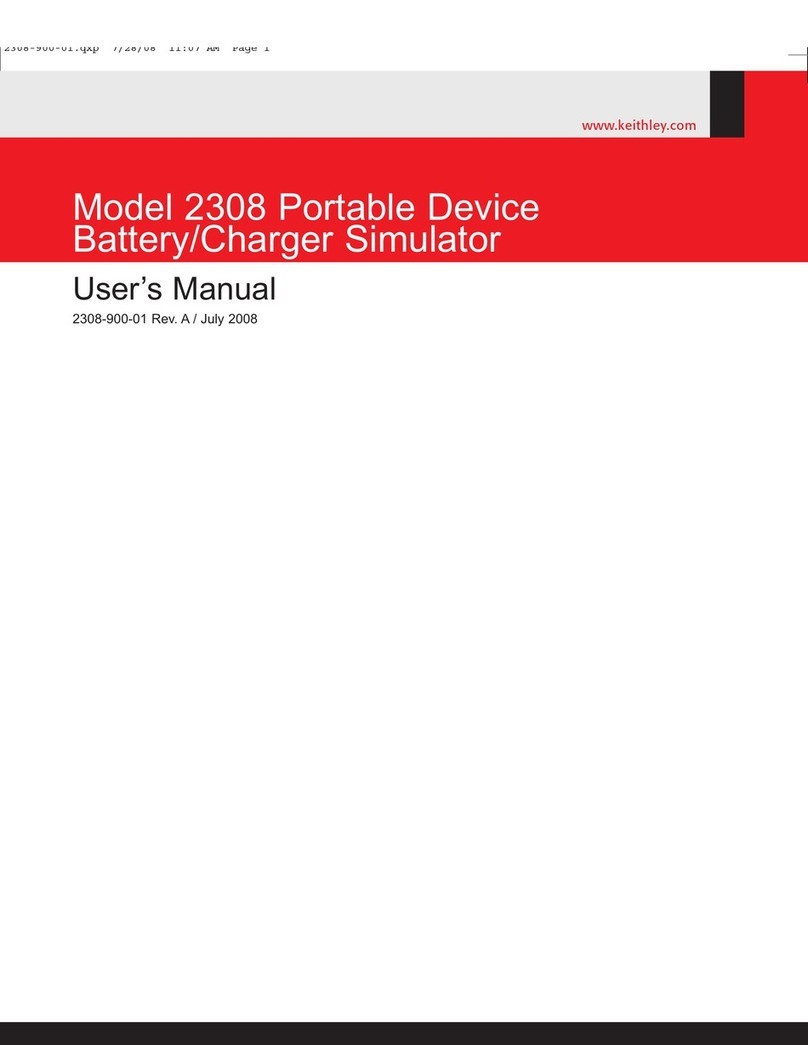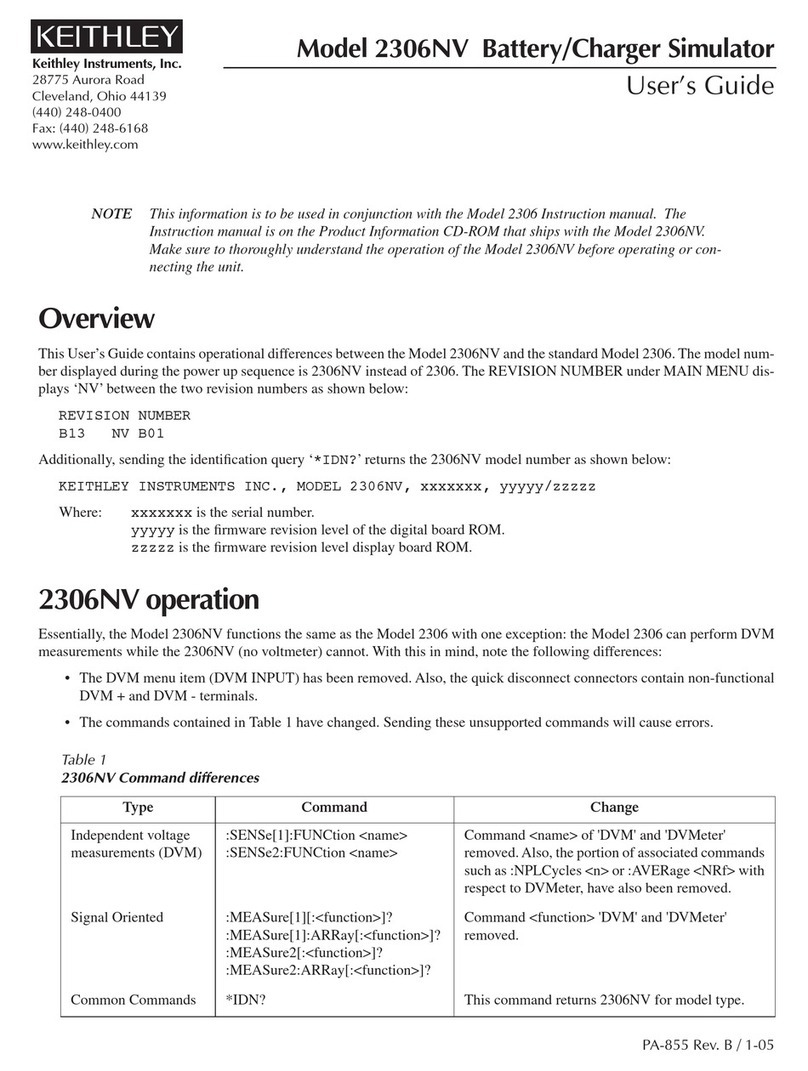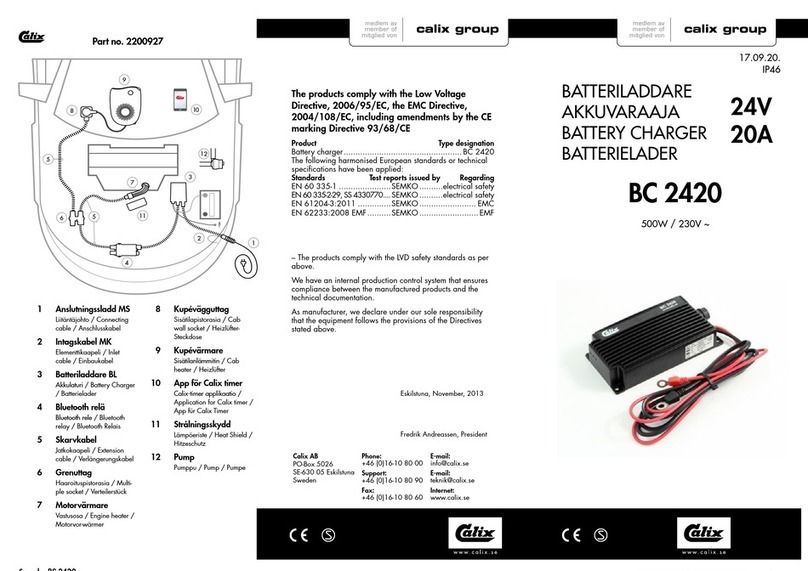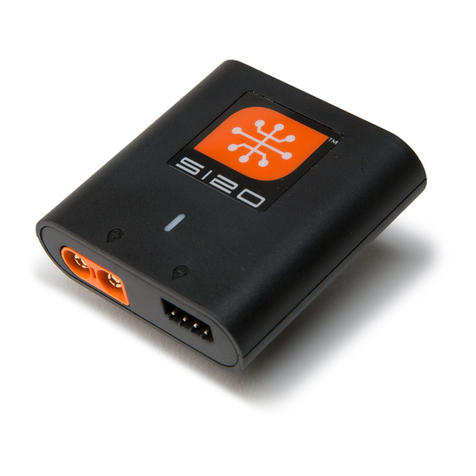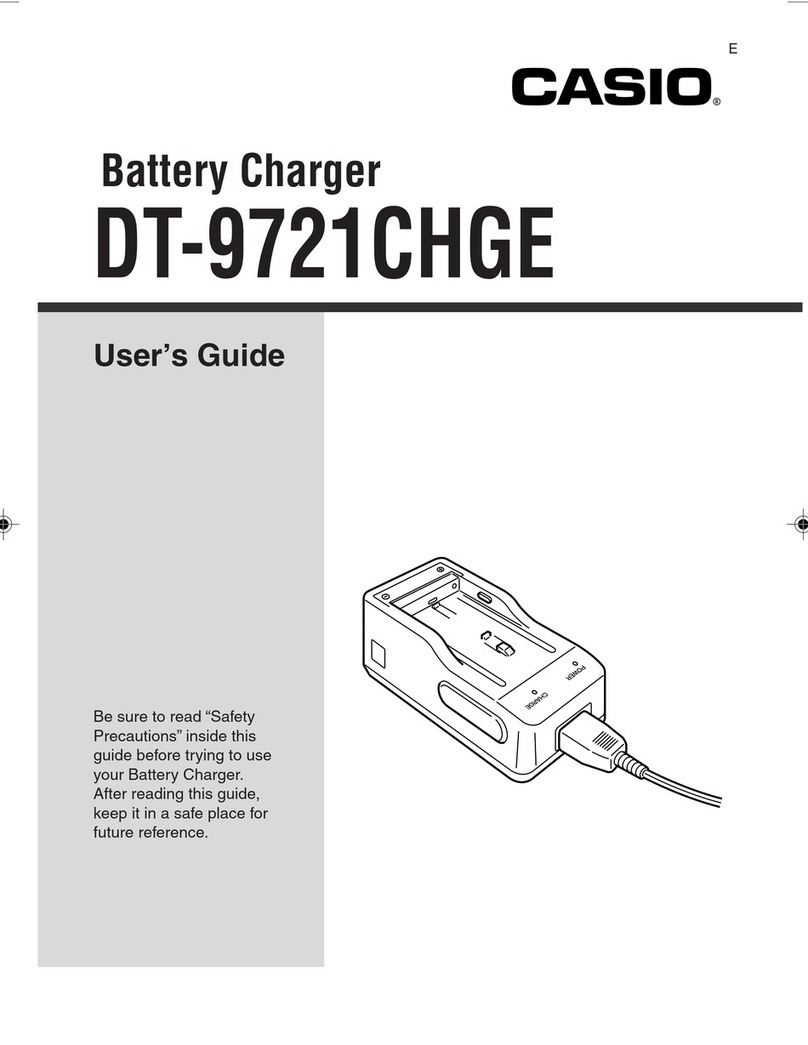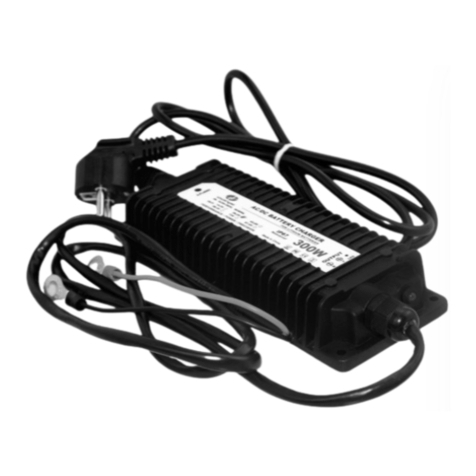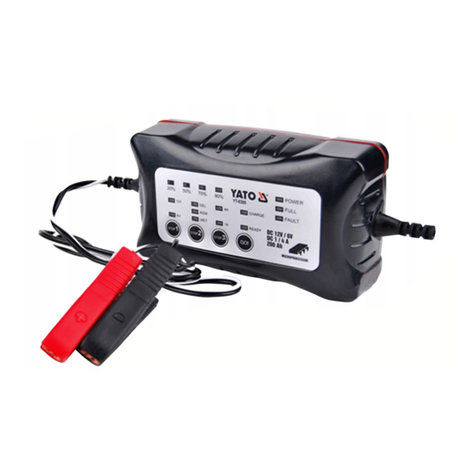Keithley 2308 User manual

www.keithley.com
A GREATER MEASURE OF CONFIDENCE
www.keithley.com
A GREATER MEASURE OF CONFIDENCE
Model 2308 Portable Device
Battery/Charger Simulator
Quick Start Guide
2308-903-01 Rev. A / July 2008
Model 2308 Portable Device
Battery/Charger Simulator
Quick Start Guide
2308-903-01 Rev. A / July 2008
2308-903-01.qxp 7/28/08 11:08 AM Page 1

A G R E A T E R M E A S U R E O F C O N F I D E N C E
Keithley Instruments, Inc.
Corporate Headquarters • 28775 Aurora Road • Cleveland, Ohio 44139
440-248-0400 • Fax: 440-248-6168 • 1-888-KEITHLEY (1-888-534-8453) • www.keithley.com
3/07
WARRANTY
Keithley Instruments, Inc. warrants this product to be free from defects in material and workmanship for a period of
one (1) year from date of shipment.
Keithley Instruments, Inc. warrants the following items for 90 days from the date of shipment: probes, cables,
software, rechargeable batteries, diskettes, and documentation.
During the warranty period, Keithley Instruments will, at its option, either repair or replace any product that proves
to be defective.
To exercise this warranty, write or call your local Keithley Instruments representative, or contact
Keithley Instruments headquarters in Cleveland, Ohio. You will be given prompt assistance and return instructions.
Send the product, transportation prepaid, to the indicated service facility. Repairs will be made and the product
returned, transportation prepaid. Repaired or replaced products are warranted for the balance of the original
warranty period, or at least 90 days.
LIMITATION OF WARRANTY
This warranty does not apply to defects resulting from product modification without Keithley Instruments’ express
written consent, or misuse of any product or part. This warranty also does not apply to fuses, software,
non-rechargeable batteries, damage from battery leakage, or problems arising from normal wear or failure to follow
instructions.
THIS WARRANTY IS IN LIEU OF ALL OTHER WARRANTIES, EXPRESSED OR IMPLIED, INCLUDING ANY
IMPLIED WARRANTY OF MERCHANTABILITY OR FITNESS FOR A PARTICULAR USE. THE REMEDIES
PROVIDED HEREIN ARE BUYER’S SOLE AND EXCLUSIVE REMEDIES.
NEITHER KEITHLEY INSTRUMENTS, INC. NOR ANY OF ITS EMPLOYEES SHALL BE LIABLE FOR ANY
DIRECT, INDIRECT, SPECIAL, INCIDENTAL, OR CONSEQUENTIAL DAMAGES ARISING OUT OF THE USE
OF ITS INSTRUMENTS AND SOFTWARE, EVEN IF KEITHLEY INSTRUMENTS, INC. HAS BEEN ADVISED IN
ADVANCE OF THE POSSIBILITY OF SUCH DAMAGES. SUCH EXCLUDED DAMAGES SHALL INCLUDE, BUT
ARE NOT LIMITED TO: COST OF REMOVAL AND INSTALLATION, LOSSES SUSTAINED AS THE RESULT OF
INJURY TO ANY PERSON, OR DAMAGE TO PROPERTY.

Safety Precautions
11/07
The following safety precautions should be observed before using this product and any associated instrumentation. Although some
instruments and accessories would normally be used with non-hazardous voltages, there are situations where hazardous conditions may
be present.
This product is intended for use by qualified personnel who recognize shock hazards and are familiar with the safety precautions required
to avoid possible injury. Read and follow all installation, operation, and maintenance information carefully before using the product. Refer
to the user documentation for complete product specifications.
If the product is used in a manner not specified, the protection provided by the product warranty may be impaired.
The types of product users are:
Responsible body is the individual or group responsible for the use and maintenance of equipment, for ensuring that the equipment is
operated within its specifications and operating limits, and for ensuring that operators are adequately trained.
Operators use the product for its intended function. They must be trained in electrical safety procedures and proper use of the instrument.
They must be protected from electric shock and contact with hazardous live circuits.
Maintenance personnel perform routine procedures on the product to keep it operating properly, for example, setting the line voltage or
replacing consumable materials. Maintenance procedures are described in the user documentation. The procedures explicitly state if the
operator may perform them. Otherwise, they should be performed only by service personnel.
Service personnel are trained to work on live circuits, perform safe installations, and repair products. Only properly trained service
personnel may perform installation and service procedures.
Keithley Instruments products are designed for use with electrical signals that are rated Measurement Category I and Measurement
Category II, as described in the International Electrotechnical Commission (IEC) Standard IEC 60664. Most measurement, control, and
data I/O signals are Measurement Category I and must not be directly connected to mains voltage or to voltage sources with high transient
over-voltages. Measurement Category II connections require protection for high transient over-voltages often associated with local AC
mains connections. Assume all measurement, control, and data I/O connections are for connection to Category I sources unless otherwise
marked or described in the user documentation.
Exercise extreme caution when a shock hazard is present. Lethal voltage may be present on cable connector jacks or test fixtures. The
American National Standards Institute (ANSI) states that a shock hazard exists when voltage levels greater than 30V RMS, 42.4V peak,
or 60VDC are present. A good safety practice is to expect that hazardous voltage is present in any unknown circuit before measuring.
Operators of this product must be protected from electric shock at all times. The responsible body must ensure that operators are
prevented access and/or insulated from every connection point. In some cases, connections must be exposed to potential human contact.
Product operators in these circumstances must be trained to protect themselves from the risk of electric shock. If the circuit is capable of
operating at or above 1000V, no conductive part of the circuit may be exposed.
Do not connect switching cards directly to unlimited power circuits. They are intended to be used with impedance-limited sources. NEVER
connect switching cards directly to AC mains. When connecting sources to switching cards, install protective devices to limit fault current
and voltage to the card.
Before operating an instrument, ensure that the line cord is connected to a properly-grounded power receptacle. Inspect the connecting
cables, test leads, and jumpers for possible wear, cracks, or breaks before each use.

When installing equipment where access to the main power cord is restricted, such as rack mounting, a separate main input power
disconnect device must be provided in close proximity to the equipment and within easy reach of the operator.
For maximum safety, do not touch the product, test cables, or any other instruments while power is applied to the circuit under test.
ALWAYS remove power from the entire test system and discharge any capacitors before: connecting or disconnecting cables or jumpers,
installing or removing switching cards, or making internal changes, such as installing or removing jumpers.
Do not touch any object that could provide a current path to the common side of the circuit under test or power line (earth) ground. Always
make measurements with dry hands while standing on a dry, insulated surface capable of withstanding the voltage being measured.
The instrument and accessories must be used in accordance with its specifications and operating instructions, or the safety of the
equipment may be impaired.
Do not exceed the maximum signal levels of the instruments and accessories, as defined in the specifications and operating information,
and as shown on the instrument or test fixture panels, or switching card.
When fuses are used in a product, replace with the same type and rating for continued protection against fire hazard.
Chassis connections must only be used as shield connections for measuring circuits, NOT as safety earth ground connections.
If you are using a test fixture, keep the lid closed while power is applied to the device under test. Safe operation requires the use of a lid
interlock.
If a screw is present, connect it to safety earth ground using the wire recommended in the user documentation.
The symbol on an instrument indicates that the user should refer to the operating instructions located in the user documentation.
The symbol on an instrument shows that it can source or measure 1000V or more, including the combined effect of normal and
common mode voltages. Use standard safety precautions to avoid personal contact with these voltages.
The symbol on an instrument shows that the surface may be hot. Avoid personal contact to prevent burns.
The symbol indicates a connection terminal to the equipment frame.
If this symbol is on a product, it indicates that mercury is present in the display lamp. Please note that the lamp must be properly
disposed of according to federal, state, and local laws.
The WARNING heading in the user documentation explains dangers that might result in personal injury or death. Always read the
associated information very carefully before performing the indicated procedure.
The CAUTION heading in the user documentation explains hazards that could damage the instrument. Such damage may invalidate the
warranty.
Instrumentation and accessories shall not be connected to humans.
Before performing any maintenance, disconnect the line cord and all test cables.
To maintain protection from electric shock and fire, replacement components in mains circuits - including the power transformer, test leads,
and input jacks - must be purchased from Keithley Instruments. Standard fuses with applicable national safety approvals may be used if
the rating and type are the same. Other components that are not safety-related may be purchased from other suppliers as long as they
are equivalent to the original component (note that selected parts should be purchased only through Keithley Instruments to maintain
accuracy and functionality of the product). If you are unsure about the applicability of a replacement component, call a Keithley Instruments
office for information.
To clean an instrument, use a damp cloth or mild, water-based cleaner. Clean the exterior of the instrument only. Do not apply cleaner
directly to the instrument or allow liquids to enter or spill on the instrument. Products that consist of a circuit board with no case or chassis
(e.g., a data acquisition board for installation into a computer) should never require cleaning if handled according to instructions. If the
board becomes contaminated and operation is affected, the board should be returned to the factory for proper cleaning/servicing.
!

Model 2308 Portable Device
Battery/Charger Simulator
Quick Start Guide
©2008, Keithley Instruments, Inc.
All rights reserved.
Any unauthorized reproduction, photocopy, or use the information herein, in whole or in part, without the prior written
approval of Keithley Instruments, Inc. is strictly prohibited.
TSP, TSP-Link, and TSP-Net are trademarks of Keithley Instruments, Inc. All other brand names are trademarks or
registered trademarks of their respective holders.
Cleveland, Ohio, U.S.A.
2308-903-01 Rev. A / July 2008
Document Number:

Title Page
Introduction ................................................................................................. 1-1
Performance features........................................................................... 1-1
Proper supply connections to the DUT ....................................................... 1-2
Front-panel operation ................................................................................. 1-7
Menu controls....................................................................................... 1-7
Setting the output voltage, current limit, and current range.................. 1-7
Turning supply output ON/OFF ............................................................ 1-7
V and I display modes (Single and Dual) ............................................. 1-8
DVM input mode (Channel 2 Only) .................................................... 1-11
Pulse current mode ............................................................................ 1-12
Long integration mode ....................................................................... 1-21
Variable output impedance control on battery channel............................. 1-26
Variable output bandwidth ........................................................................ 1-27
Front-panel operation for output bandwidth ....................................... 1-27
Advanced features.................................................................................... 1-28
Analog output ..................................................................................... 1-28
Optimizing measurement speed ........................................................ 1-29
Table of Contents

Figure Title Page
Figure 1 Model 2308 front panel ................................................................................. 1
Figure 2 Rear-panel view of Model 2308 ................................................................... 3
Figure 3 Battery channel preferred connection (maximum stability) ........................... 4
Figure 4 Battery channel fastest transient response connection ............................... 5
Figure 5 Charger channel 4-wire remote sense connection of the
DUT to the output ...................................................................................... 6
Figure 6 Charger Control Circuit Testing .................................................................... 11
Figure 7 Pulsed waveform ........................................................................................ 13
Figure 8 Eliminating the effect of a current transient on a pulse current
measurement ........................................................................................... 14
Figure 9 Determining voltage and current characteristics for battery channel .......... 19
Figure 10 Pulsed waveform ........................................................................................ 21
Figure 11 Analog output .............................................................................................. 28
List of Figures

Introduction 1
Introduction
This guide is designed to familiarize users of the Keithley Model 2308 Portable
Device Battery/Charger Simulator with the basic operating features available from
the instrument’s front panel and also the GPIB bus. The sequence of operating
instructions reflects the order in which the instrument would be configured for a
typical application. For each operating mode, an example set of bus commands is
provided. While the SCPI command strings are generic, the exact programming
syntax will depend on the test program language.
Figure 1
Model 2308 front panel
Performance features
• The Model 2308 is a specialized power supply that has a very fast recovery
to large, near instantaneous load current transitions. Conventional power
supplies do not have this capability. The Model 2308 is designed
specifically to respond to large load changes and very short pulsed loads
with small transient voltage drop and a very fast recovery time. Typical
devices that have these types of characteristic loads are mobile phones,
NOTE For additional information about any feature discussed in this
guide (including programming examples), refer to the Model
2308 Portable Device Battery/Charger Simulator User's Manual
(part number 2308-900-01 (A - July 2008)).
POWER
DISPLAY
OPERATE
ENTER SET
MENU
LOCAL
2308 Portable Device attery/Charger Simulator

2 Proper supply connections to the DUT
wireless communication modules, and other portable, battery operated
devices. The Model 2308 can maintain a near-constant output, even under
quickly-changing load conditions.
• The power supply can measure a wide range of load currents. It can
resolve down to 0.1 μA and measure up to 5 A. It has fast measurement
capability as well and can measure load current pulses as narrow as
50 μsec.
• The Model 2308 can simulate the output of a battery. Its programmable
output resistance can simulate a battery’s internal resistance so that the
voltage output looks like that of a battery’s output.
• The two channels can also sink current so that one channel (the battery
channel) simulates a discharged battery, while the other channel (the
charger channel) can be used to simulate a charger
Proper supply connections to the DUT
Figure 2 shows a detailed rear-panel view of the Model 2308 detailing the
connector sockets for the battery channel OUTPUT #1 and the charger channel
OUTPUT #2. Figure 3 and Figure 4 show optimum remote 4-wire connections for
device-under-test (DUT) preferred connection (Figure 3)and fastest transient
response connection (Figure 4).
WARNING When installing a unit into a test system, make sure the
external power sources do not apply voltage to the power
supply in excess of its maximum limits (see specifications).
Failure to do so could result in personal injury or death.
The power cord supplied with the Model 2308 contains a
separate ground for use with grounded outlets. When
proper connections are made, instrument chassis is
connected to power line ground through the ground wire in
the power cord. Failure to use a grounded outlet may result
in personal injury or death due to electric shock.
NOTE The Model 2308 does not have an internal local sense
connection. Therefore, you must connect the DUT to the supply
in either a remote or local sense configuration so that the Model
2308 can output a controlled voltage.

Proper supply connections to the DUT 3
For the most accurate 4-wire remote sense application, the source and the sense
inputs to the supply must be connected as close to the inputs of the load as
possible through twisted pair leads as shown in Figure 3, Figure 4, and Figure 5.
Figure 2
Rear-panel view of Model 2308
WARNING:NO INTERNAL OPERATOR SERVICA LE PARTS,SERVICE Y QUALIFIED PERSONNEL ONLY.
CAUTION:FOR CONTINUED PROTECTION AGAINST FIRE HAZARD,REPLACE FUSE WITH SAME TYPE AND RATING.
MADE IN
U.S.A.
LINE RATING
100-120VAC, 200-240VAC
50, 60 HZ 165VA MAX
LINE FUSE
SLOWBLOW
2.0A, 250V
IEEE-488
(ENTER IEEE ADDRESS
FROM FRONT PANEL MENU)
REMOTE
DISPLAY
OPTION
+++
___
SOURCE SENSE SOURCE
OUTPUT #1
ISOLATION FROM EARTH: 22 VOLTS MA MA .
RELAY
CONTROL
24VDC MAX
DVM IN
-30 VDC MAX
ANALOG
OU
mA
(5/50)
A
(0.5/5)
+++
____+
SOURCE SENSE DVM IN
SOURCE
OUTPUT #2

4 Proper supply connections to the DUT
Figure 3
Battery channel preferred connection (maximum stability)
NOTE Twist source leads together and twist sense leads together for
optimum performance.
The analog outputs provide a voltage output based on the
measured current as follows:
0.5/5 A Output referenced to Source - : 1 A/V (each volt out
represents 1A)
5/50 mA Output referenced to Source - : 10 mA/V (each volt out
represents 10 mA)
Quick Disconnect
Connector
DU
Source -
Source -
Sense -
Sense +
Source +
Source +
wisted Pair
(5mA/50mA)
(0.5A/5A)
Analog
Outputs
Internal
Oscilloscope
or
Digitizer
Load est Leads
10mA/V
1A/V

Proper supply connections to the DUT 5
Figure 4
Battery channel fastest transient response connection
NOTE Twist source leads together and twist sense leads together for
optimum performance.
The analog outputs provide a voltage output based on the
measured current as follows:
0.5/5 A Output referenced to Source - : 1 A/V (each volt out
represents 1A)
5/50 mA Output referenced to Source - : 10 mA/V (each volt out
represents 10 mA)
Quick Disconnect
Connector
DU
Source -
Source -
Sense -
Sense +
Source +
Source +
wisted Pair
(5mA/50mA)
(0.5A/5A)
Analog
Outputs
Internal
Oscilloscope
or
Digitizer
Load est Leads
1A/V
10mA/V

6 Proper supply connections to the DUT
Figure 5
Charger channel 4-wire remote sense connection of the DUT to the output
NOTE Twist Source leads together and twist Sense leads together for
optimum performance.
External est Circuit
Quick Disconnect
Connector
Model 2308
Source Input/Output
DVM Input
DU
+
-
DVM +
DVM -
Source -
Source -
Sense -
Sense +
Source +
Source +
wisted Pair

Front-panel operation 7
Front-panel operation
Menu controls
• Press the MENU key to activate the main menu.
•Usethe▲and ▼keys to scroll through the primary menu items.
• Changing channels: when the main menu is displayed, use the or keys
to change the active channel (each press of the or keys will toggle
between Channel #1 and Channel #2). If no change happens then the
feature is most likely a single channel or system feature.
Setting the output voltage, current limit, and current range
The default current measurement range is 5 A.
For a lower current range, select the CURRENT RANGE item of the menu:
1. Press the MENU key.
2. Press
▲or ▼keys to scroll to Current Range.
3. Press the or keys to scroll to Current Range #1 or Current Range #2.
4. Press the ENTER key to select.
5. Press the
▲or ▼keys to scroll to the desired current range.
6. Press the ENTER key to select.
To set the output voltage and current limit:
1. Press the SET key to select the output settings mode. A blinking cursor
appears in the voltage field of the display.
2. Press the
▲, ▼, , or keys to scroll to the desired output voltage value.
• The cursor position (blinking digit) is controlled by the or keys.
• With the cursor positioned on a digit, increment or decrement the value
using the ▲or ▼keys.
3. Press SET to move the blinking cursor to the current limit field.
4. Press the
▲, ▼, , or keys to scroll to the desired current limit.
5. Press SET to exit from output settings mode.
Turning supply output ON/OFF
The OPERATE key is used to control the output of the power supply. This key
toggles the output between on and off. While in one of the display modes, output
ON or OFF is displayed in the upper right corner of the display. The key is active in
any front-panel menu or display mode. In menus, the ON/OFF state of operate is
not displayed.
▲
▲
▲
▲
▲
▲
▲
▲
▲
▲
▲
▲

8 Front-panel operation
V and I display modes (Single and Dual)
Measured output voltages and currents are displayed with the Single or Dual V and
I display modes selected. These display modes are selected as follows:
1. Press the DISPLAY key.
2. Press the ▲or ▼keys to scroll to SINGLE V AND I or DUAL V AND I.
3. For Single V and I, press the or keys to scroll to Channel #1 or #2.
4. Press the ENTER key to select.
Voltage readings are located on the top line of the display and current readings are
located on the bottom line for single V and I mode. For Dual V and I mode, the top
line shows voltage, current and output state for Channel 1 while the bottom line
shows voltage, current and output state for Channel 2.
NPLC rate
The integration (reading) rate of the instrument is specified as a parameter based
on the number of power-line cycles (NPLC), where 1 PLC for 60Hz line frequency
NOTE To display measured readings if the instrument is in the settings
mode, press the SET key until the blinking stops (the measured
readings can then be displayed). To determine if the instrument
is in the settings mode, check for a blinking cursor in a digit of
the voltage or current field (if present, the instrument is in the
setting mode).
NOTE For dual channel mode, the Dual Channel display mode shows
voltages, current and output state for both channels. For single
channel mode, the single channel display mode shows voltage,
current and output state for the active channel only.
Table 1
Display mode examples
Display mode Samples for battery
channel (#1)
Samples for charger
channel (#2)
Single V and I: 6.116V #1 ON 6.116 V #2 ON
1.2058 A 1.2058 A
Dual V and I: 2.97V 25.7m 1# 2.97V 25.7m 1
0.00V 0.00A 0 1.00V 0.17A 1#
▲
▲

Front-panel operation 9
is 16.67msec. In general, the fastest integration time (0.002 PLC) results in
increased reading noise. The slowest integration time (10 PLC) provides the best
common-mode and normal-mode rejection. In between settings are a compromise
between speed and noise. The NPLC RATE #2 item of the menu is also used to
set the reading rate for DVM measurements on the charger channel.
Average readings
The average reading count (1 to 10) specifies the number of measurement
conversions to average for each reading. For example, with a reading count of 5,
each displayed reading will be the average of five measurement conversions. The
AVER READINGS #2 menu items are also used to set the average reading count
for DVM measurements on the charger channel.
Programming examples: outputting and reading back V and I
The following command sequences demonstrate how to output voltage and
current, and read back (measure) the actual voltage and current:
Battery channel (#1)
VOLT 5 ‘ Set output voltage to 5 V.
SENS:CURR:RANG:AUTO ON ‘ Enable auto range for current.
CURR 750e-3 ‘ Set current limit to 750 mA.
CURR:TYPE TRIP ‘ Select Trip mode for current limit.
SENS:FUNC ‘VOLT’ ‘ Select the voltage measurement function.
SENS:NPLC 2 ‘ Set integration rate to 2 PLC.
SENS:AVER 5 ‘ Set average reading count to 5.
OUTP ON ‘ Turn on the power supply output.
READ? ‘ Trigger 5 voltage measurement conversions
and return the average of those 5
conversions. The average reading is
displayed on the front panel.
SENS:FUNC ‘CURR’ ‘ Select current measurement function.
NOTE NPLC RATE is not used to set the integration rate for pulse
current and long integration measurements. These
measurements are covered in the paragraphs titled Pulse
current mode and Long integration mode.
NOTE AVER READINGS is not used to set the average reading count
for pulse current and long integration measurements. Refer to
applicable sections of this guide for information on setting the
average reading count for pulse current and long integration
measurements.

10 Front-panel operation
READ? ‘ Trigger 5 current measurement conversions
and return the average of those 5
conversions. The average of the 5 readings
is displayed on the front panel.
Charger channel (#2)
SOUR2:VOLT 5 ‘ Set output voltage to 5 V.
SENS2:CURR:RANG:AUTO ON ‘ Enable auto range for current.
SOUR2:CURR 750e-3 ‘ Set current limit to 750 mA.
SOUR2:CURR:TYPE LIM ‘ Select LIM mode for current limit.
SENS2:FUNC ‘VOLT’ ‘ Select the voltage measurement function.
SENS2:NPLC 4 ‘ Set integration rate to 4 PLC.
SENS2:AVER 4 ‘ Set average reading count to 4.
OUTP2 ON ‘ Turn on the power supply output.
READ2? ‘ Trigger 4 voltage measurement conversion and
return the average of those 4 conversions.
SENS2:FUNC ‘CURR’ ‘ Select current measurement function.
READ2:ARR? ‘ Trigger 4 current measurement conversions
and return all 4 conversions. The average of
the 4 readings is displayed on the front
panel.

Front-panel operation 11
Figure 6
Charger Control Circuit Testing
DVM input mode (Channel 2 Only)
The DVM input display mode must be selected in order to measure voltage applied
to the DVM input of the power supply. This display mode is selected as follows:
1. Press the DISPLAY key to access the display menu.
2. Press the or keys to scroll to DISPLAY TYPE #2 since DVM is channel
2 only feature.
3. Press the ▲or ▼keys to scroll to DVM INPUT.
4. Press ENTER to select.
NOTE For Channel 1 to simulate a discharged battery (by sinking
current) and for Channel 2 to simulate a charger, program the
Channel 2 voltage to be greater than the Channel 1 voltage.
Channel 1 DU Channel 2
Program Vchan2 > VChan1 to force Channel 1 to sink current
▲
▲

12 Front-panel operation
Programming examples: making voltage measurements with
the DVM
The following command sequence demonstrates how to measure voltage applied
to the DVM input of the power supply:
Charger channel (#2)
SENS2:FUNC ‘DVM’ ‘ Select the DVM input function.
SENS2:NPLC 3 ‘ Set integration rate to 3 PLC.
SENS2:AVER 8 ‘ Set average reading count to 8.
READ2:ARR? ‘ Trigger and return 8 readings. The average
of the 8 readings is displayed on the front
panel.
Pulse current mode
Description
The Model 2308 can perform pulsed current measurements for dynamic loads.
The built-in measurements include:
1. Peak measured current - measures the peak (high) current of the pulse train.
2. Idle measured current - measures the idle (low) current of the pulse train.
3. Average transmitted current - measures the average current of the pulse
train.
The high measurement is triggered on the rising edge of the pulse (Figure 7) and
integration is performed for the time specified for the high measurement. The falling
edge of the pulse triggers the low measurement, and an integration is performed
for the time specified for the low measurement. An average measurement is
triggered on the rising edge, and covers both the high and low periods of the pulse
as specified by the average measurement time setting. The Model 2308 computes
one measurement parameter, high, low, or average, at a time. The desired
measurement mode on the front panel is selected with the ▲or ▼keys.
The GPIB commands TIMEOUT, SEARCH, DETECT, and FAST are available in
pulse current mode to optimize measurement speed. For the relevance and use
of these commands regarding a particular measurement application, refer to the
Model 2308 Instruction Manual, Section 3, Pulse Current Measurements.
The pulse measurement period can be selected manually or be automatically set
by the Model 2308. First, the user must specify a trigger level that serves as a
NOTE See Section 3 in the Model 2308 Instruction Manual for
information on pulse current step and digitizing commands.

Front-panel operation 13
threshold to initiate the integration process. Once the trigger level is selected, the
output is turned on and the pulsed load measurement is operational, the 2308 can
be prompted to automatically determine the high time, low time, and average time
in pulsed current mode according to Figure 7. These parameters may also be set
manually from the front panel or over the GPIB bus.
Figure 7
Pulsed waveform
The pulsed response of a device is rarely a perfect square wave. Figure 8 shows
the current response of a typical GSM handset during the transmit portion of the
data frame. Using the built in auto-time feature with a trigger threshold of 0.2 amp
and no trigger delay, the Model 2308 will automatically set the HIGH integration
time, denoted by TH1, to 533 μs. For this value of HIGH integration time, the effect
of the current transient at the beginning of the pulse is included in the
measurement. Although in this example the effect of the current transient on the
measurement is small, the user can eliminate the effect of the transient by adding
a suitable amount of trigger delay. In this case, a delay of 100 μs is sufficient to
eliminate the effect of the transient, approximately 70 μs, from the measurement.
Accordingly, the HIGH integration time, TH2, must be reduced, in this case 300 μs
was chosen, so the integration time does not extend into a section of the pulse the
user does not want to measure.
NOTE The pulsed waveform in Figure 7 shows trigger level and the
high, low, and average times set by the Model 2308 using the
auto-time feature.
rigger
level Average current
level
High current level
Low current level
High
time
Low
time
Average time
Other manuals for 2308
1
Table of contents
Other Keithley Batteries Charger manuals
Popular Batteries Charger manuals by other brands

HEINE OPTOTECHNIK
HEINE OPTOTECHNIK NT300 manual

Hardy Barth
Hardy Barth cPH2 Series Installation and operating manual
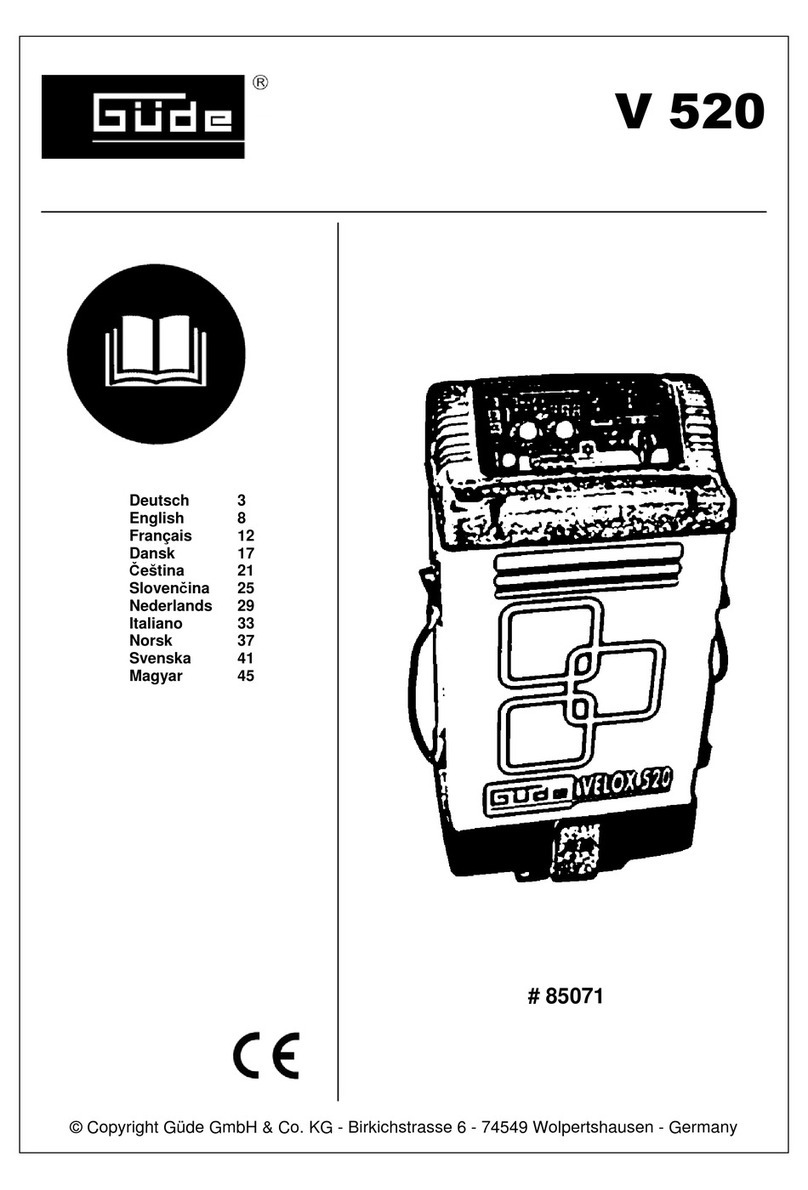
Gude
Gude Velox 520 operating manual
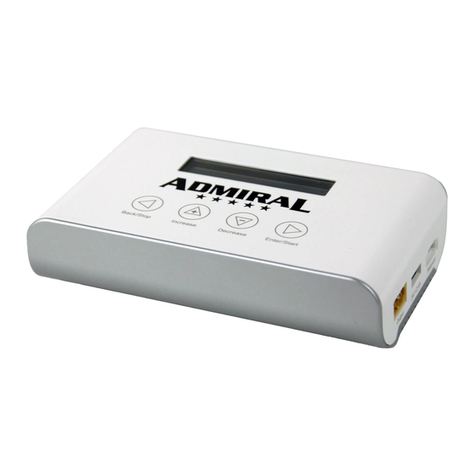
Admiral
Admiral ADM6026-002 instruction manual
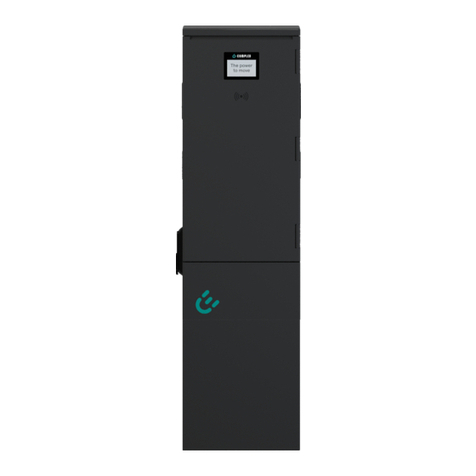
Compleo
Compleo DUO bm operating instructions
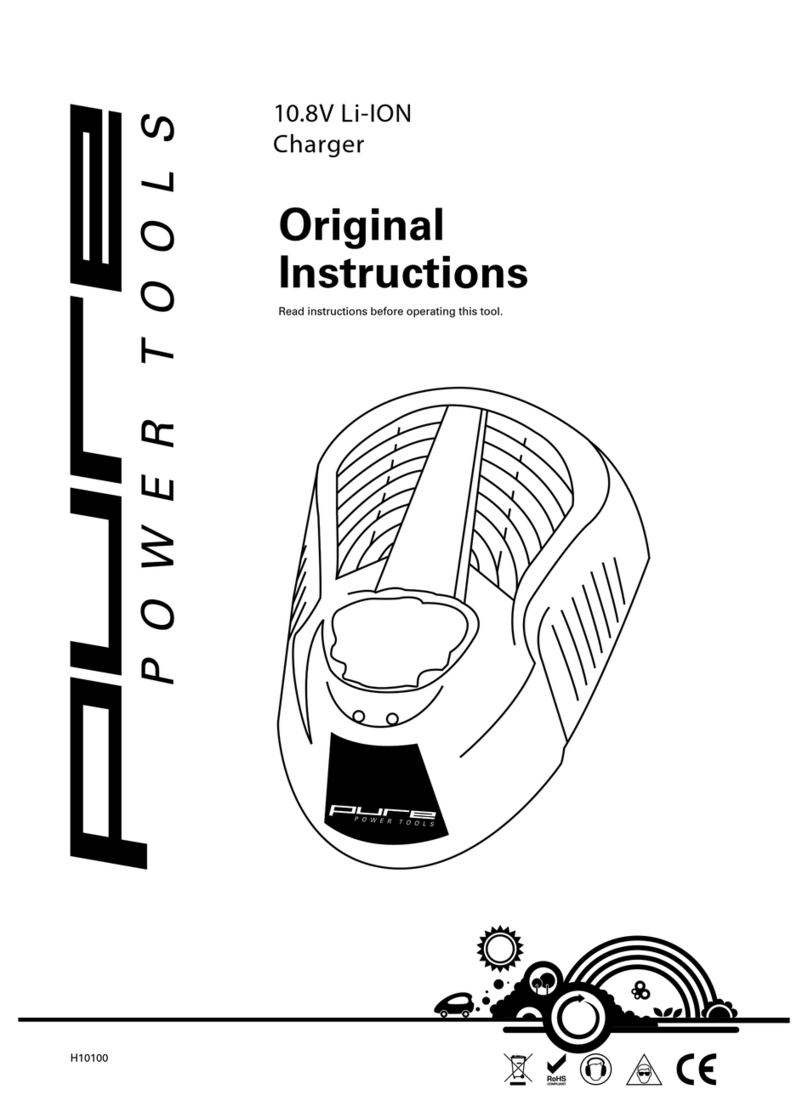
Pure Power Tools
Pure Power Tools PURECHARGER2 Original instructions

